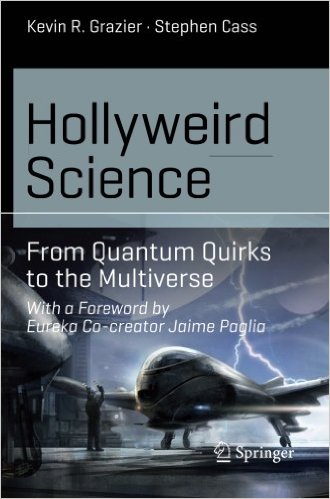
Dr. Kevin Grazier has made a career of studying intergalactic planetary formation, and, over the last few years, helping Hollywood writers integrate physics smartly into storylines for popular TV shows like Battlestar Galactica, Eureka, Defiance and the blockbuster film Gravity. His latest book, Hollyweird Science: From Quantum Quirks to the Multiverse traverses delightfully through the science-entertainment duality as it first breaks down the portrayal of science in movies and television, grounding the audience in screenplay lexicon, then elucidates a panoply of physics and astronomy principles through the lens of storylines, superpowers and sci-fi magic. With the help of notable science journalist Stephen Cass, Hollyweird Science is accessible to the layperson sci-fi fan wishing to learn more about science, a professional scientist wanting to apply their knowledge to higher-order examples from TV and film or Hollywood writers and producers of future science-based materials. From case studies, to in-depth interviews to breaking down the Universe and its phenomena one superhero and far-away galaxy at a time, this first volume of an eventual trilogy is the essential foundation towards understanding how science is integrated into a story and ensuring that future TV shows and movies do so more accurately than ever before. Full ScriptPhD review and podcast with author and science advisor Dr. Grazier below.
Most people who watch movies and TV shows never went to film school. They are not familiar with the intricacies of three-act structure, tropes, conceits and MacGuffins that are the skeletal framework of a standard storytelling toolkit. Yet no genre is more rooted in and dependent on setup and buying into a payoff than sci-fi and films conceptualized in scientific logic. Many, if not most, critiques of science in entertainment don’t fully acknowledge that integrating abstruse science/technology with the complex constraints of time, length, character development and screenplay format is incredibly demanding. Hollyweird Science does point out some egregious examples of “information pollution” and the “Hollywood Curriculum Cycle” – the perpetuation bad, if not fictitious, science. But after grounding the reader in a primer of the fundamental building blocks of movie-making and TV structure, not only is there a more positive, forgiving tone in breaking down the history of the sci-fi canon (some of which predicted many of the technological gadgets we enjoy today), but even a celebration of just how much and how often Hollywood gets the science right.
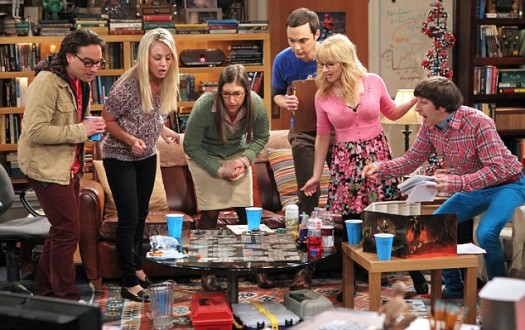
Conversely, the vast majority of Hollywood writers, producers and directors don’t regularly come across PhD scientists in real life, and have to form impressions of doctors, scientists and engineers based on… other portrayals in entertainment. Scientists, after all, represent only 0.2 percent of the U.S. population as a whole, and less than 700,000 of all jobs belong to doctors and surgeons. And while these professions are amply represented on screen in number, that’s not necessarily been the case in accuracy. The insular self-reliance of screenwriters on their own biases has led to stereotyping and pigeonholing of scientists into a series of familiar archetypes (nerds, aloof omniscient sidekicks), as Grazier and Cass take us through a thorough, labyrinthine archive of TV and movie scientists. But as scientists have become more involved in advising productions, and have become more prominent and visible in today’s innovation-driven society, their on screen counterparts have likewise become a more accurate reflection of these demographics – mainstream hits like The Big Bang Theory, CSI (and its many procedural spinoffs), Breaking Bad and films like Gravity, The Martian, Interstellar and The Imitation Game are just a recent sampling.

If you’re going to teach a diverse group of readers about the principles of physics, astronomy, quantum mechanics and energy forms, it’s best to start with the basics. Even if you’ve never picked up a physics textbook, Hollyweird Science provides a fundamental overview of matter, mass, elements, energy, planet and star formation, time, radiation and the quantum mechanics of universe behavior. More important than what these principles are, Grazier discerns what they are not, with running examples from iconic television series, movies and sci-fi characters. What exactly is the difference between weight and mass and force, per the opening scene of the film Gravity? How are different forms of energy classified? Are the radioactive giants of Godzilla and King Kong realistic? What exactly happens when Scotty is beamed up? Buoying the analytical content are a myriad of interviews with writers and producers, expounding honestly about working with scientists, incorporating science into storytelling and where conflicts arose in the creative process.

People who want to delve into more complex science can do so through “science boxes” embedded throughout the book – sophisticated mathematical and physics analyses of entertainment staples, trivial and significant. Among my favorites: why Alice in Wonderland is a great example of allometric scaling, the thermal radiation of cinematography lighting, hypothesizing Einsteinian relativity for the Back To The Future DeLorean, and just how hot is The Human Torch in the Fantastic Four? (Pretty dang hot.)
The next time readers see an asteroid making a deep impact, characters zipping through interplanetary travel, or an evil plot to harbor a new form of destructive energy, they’ll have a scientific foundation to ask simple, but important, questions. Is this reasonable science, rooted in the principles of physics? Even if embellished for the sake of advancing a story, could it theoretically happen? And for Hollywood writers, how can science advance a plot or help a character solve their connundrum? In our podcast below, Dr. Grazier explains why physics and astronomy were such an important bedrock of the first book – and of science-based entertainment – and previews what other areas of science, technology and medicine future sequels will analyze.
In the long run, Hollyweird Science will serve as far more than just a groundbreaking book, regardless of its rather seamless nexus between fun pop culture break-down and serious scientific didactic tool. It’s a part of a conceptual bridge towards an inevitable intellecutal alignment between Hollywood, science and technology. Over the last 10-15 years, portayal of scientists and ubiquity of science content has increased exponentially on screen – so much so, that what was a fringe niche even 20 years ago is now mainstream and has powerful influence in public perception and support for science. Science and technology will proliferate in importance to society, not just in the form of personal gadgets, but as problem-solving tools for global issues like climate change, water access and advancing health quality. Moreover, at a time when Americans’ grasp of basic science is flimsy, at best, any material that can repurpose the universal love of movies and television to impart knowledge and generate excitement is significant. We are at the precipice of forging a permanent link between Hollywood, science and pop culture. The Hollyweird series is the perfect start.
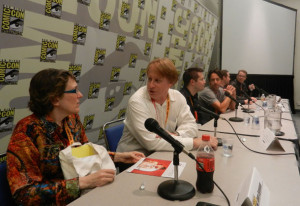
In an exclusive podcast conversation with ScriptPhD.com, Dr. Grazier discussed the overarching themes and concepts that influenced both “Hollyweird Science” and his ongoing consulting in the entertainment industry. These include:
•How the current Golden Age of sci-fi arose and why there’s more science and technology content in entertainment than ever
•Why scientists and screenwriters are remarkably similar
•Why physics and astronomy are the building blocks of the majority of science fiction
•How the “Hollyweird Science” trilogy can be used as a didactic tool for scientists and entertainment figures
•His favorite moments working both in science and entertainment
*****************
ScriptPhD.com covers science and technology in entertainment, media and advertising. Hire our consulting company for creative content development. Follow us on Twitter and Facebook. Subscribe to our podcast on SoundCloud or iTunes.

“I think we’re living through the greatest age of discovery our civilization has ever known,” declares British physics superstar Professor Brian Cox as a preamble for each episode of The Science Channel’s BBC import Wonders of the Solar System. Episode by episode, Dr. Cox deconstructs our wondrous Universe one focus at a time—the Sun, the Big Bang, life on other planets. But he does something even more important. He infuses his own obvious enthusiasm and passion for his field in each experiment and factoid. As a viewer, you can’t helped but be absorbed in the intergalactic vortex of knowledge. The timing of this mini-series and emergence of Cox’s exuberant personality could not be better. Funding for NASA missions has been cut dramatically, with an ongoing re-evaluation the role space exploration should play in the national budget and science ambition. American viewers should get used to Cox as a modern-day Carl Sagan, because his star is rising fast. ScriptPhD.com was extraordinarily fortunate to sit down with Dr. Cox in Los Angeles for a one-on-one podcast about the show, the current state of space exploration, and what is possible to achieve experimentally if we only try. My conversation with the inspirational, eloquent and brilliant Brian Cox, along with our review of Wonders of the Universe, under the “continue reading” cut.

Astronomy was never my strongest suit academically. And while I’ve always had a respectful admiration for the solar system and interplanetary sciences, I was never the kind to stargaze or spend hours on the telescope on the off-chance of spotting Mars, Venus or the Saturn rings. It’s a testament, then, to the immensity, ambition and quality of The Science Channel’s latest mini-series project, Wonders of the Solar System for holding me positively captivated while screening the first two episodes. A concept as simple as a solar eclipse is the running theme for the entirety of the first episode, “Empire of the Sun.” By the time the eclipse is recorded, it is the climax to an astounding collection of facts about how rare, precious and ordered the Sun (and its position to the Earth really is). A perfect eclipse is only possible right here on planet Earth—400 times the planetary distance away from the Moon, with the Sun an exact 400 times the diameter of the Moon. No other moon in the vast expanse of the solar system has these properties. Pretty amazing stuff, right? The timing of Wonders of the Solar System could not come at a better time. With our economic and moral spirits at a nadir, it’s time to discuss the importance of space travel and exploration to our scientific, nationalistic and optimistic psyches. President Obama’s 2011 NASA budget, while providing an increase of $6 billion for technology innovation, scrapped manned space flights, including a manned mission to the Moon and any proposals of future Mars exploration. Neil Armstrong, the first man to walk on the Moon, strongly criticized the move as handicapping spaceflight and exploratory ambition. One of the things Wonders of the Universe reminds us, and that Dr. Cox reiterated in our podcast below, is that scientific discoveries come out of limitless ambition, and often from asking completely unrelated questions. Nothing is more ambitious for mankind than exploring the Universe that houses our miraculous existence. Future episodes will examine the Wonders of our atmosphere, the similarity between our planet and Mars, and most excitingly, examining the possibilities of alien life in the solar system.

Part of the appeal of Wonders is that unlike many educational platforms that talk at the viewer in order to inform, Wonders feels like an interactive, experimental experience. When Cox isn’t zipping from one far-fetched corner of the world to another (catching an aurora borealis in the Arctic Circle! a solar eclipse in India! Mars-watching in Tunisia!), he’s pointing out cool, and often eye-catching, experiments that show viewers the science and physics that makes our solar system so fantastically unique. Who would ever know that a tornado in the Midwest is actually a physics parallel to the formation of our very universe. The scientific principle at hand—conservation of angular momentum—stopped the solar system from collapsing under its own gravity during formation, allowing a stable, rotating disc of planets to form. We all know the sun is powerful, shining 1 kW of energy for meter squared of the Earth’s surface, equal to one million times the yearly power consumption of the United States in each second! But it’s a lot more fun to watch Cox show this measurement in Death Valley with a pail of water, a thermometer, and some physics. Likewise the Sun’s sunspots, a still not quite understood phenomenon that has been correlated to the Earth’s seasons and weather, which Cox illustrates with a digital camera. All of this extemporaneous experimentation is reminiscent of the best of Carl Sagan, just with a modern twist.
The Los Angeles Times, in their television review of Wonders called Brian Cox “the nerd that’s cooler than you.” Already a budding superstar in the world of particle physics (check out his TED talk on his work at CERN’s Hadron Supercollider), Cox is that perfect mix of half-scientist, half-TV star. Without him, Wonders would be a completely different endeavor. (Listen to our podcast below as an example of his charismatic eloquence.) To boot, BBC and The Science Channel spared no expenses when it came to production values. In our one on one meeting, Cox let us in on the secret that the whole of Wonders was filmed with an old-fashioned 1970s cinematic lens, lending a decidedly movie feel to the show, particularly the graphics and digital sequences. While some imagery is real, such as amazing Martian sunsets captured by the Mars rover, other digital effects (notably in the “Empire of the Sun” episode) are stunning enough to make you feel like your television is the portal window of a spacecraft in intergalactic orbit.
Wonders of the Solar System airs on The Science Channel on Thursdays at 9 PM ET.
While in Los Angeles to promote Wonders of the Solar System, Dr. Cox graciously sat down with ScriptPhD.com to discuss the show and his views on space exploration. Among our discussion topics:
•How he is still able to channel a passion for the solar system
•Why he thinks it’s critical for NASA to take risks and go to Mars
•The possibilities of life in the outer solar system and
•Why it’s a huge mistake for NASA to cut their budget for space exploration
Take a listen below:
~*ScriptPhD*~
*****************
ScriptPhD.com covers science and technology in entertainment, media and advertising. Hire our consulting company for creative content development.
Subscribe to free email notifications of new posts on our home page.
]]>
ScriptPhD.com’s coverage of the World Science Festival in New York City continues towards the physics and mathematics realm. Day 3 events on Friday included an intimate discussion about astrophysics and the new James Webb Telescope, set to replace Hubble in June of 2014, a panel about hearing and visualizing gravity with Albert Einstein’s modern successors, and a panel about the very limits of our understanding of science—the line between what we do and don’t (or can’t) know—and its bridge to culture and art. Contributions to our coverage were done by New York City science writers Jessica Stuart and Emily Elert. Synopses and pictures of three extraordinary panels with the premier scientists of our time under the “continue reading” cut.
FROM THE CITY TO THE STARS: Star-gazing with the Webb Telescope — June 4, 2004
It was a cloudy night in Manhattan, but the dozens of amateur astronomers and spectators who came down to Battery Park didn’t seem to mind. People from all over the tri-state area brought out their telescopes, ranging from under a foot to over 7 feet long, in hopes of seeing Saturn and with luck, some other planets. Many came early in the day to set up, happy to talk to visitors about their interest in the cosmos. As the sun started to set, Dr. John Mather, Dr. John Grunsfeld, Dr Heidi Hammel, and moderator Miles O’Brien sat down to talk with about the James Webb Space Telescope and space in general. Acknowledging all of the amateur astronomers in the audience, they pointed out that in 1994, you needed the Hubble Telescope to see many of the things that their personal telescopes set up in the park could see on a clear dark night from anywhere.

O’Brien brought out a laser pointer, and Dr. Mather explained in detail all of the parts of the full-scale model of the James Webb Space Telescope that was set up nearby. He explained how, because of its size and the rocket that it will go to space on, it will launch folded up, and then deploy itself in space. Its final destination is a million miles from the earth, at a Lagrange point, where it will be stable. There will be no repair missions to the Webb Telescope, as there have been to the Hubble, which is in orbit 300 miles from earth. Dr. Grunsfeld was on three of the five repair missions to Hubble, and spoke of how amazing it was to see Neptune from that vantage point.
Audience Q&A ranged from life on other planets, the end of space, and how black holes work. The scientists were dynamic and engaging, doing their best to answer all of the questions. Fortunately, cloud cover didn’t matter and telescopes weren’t need to see the star that much of the audience was interested in. At the end of the panel discussion, Astrophysicist, Director of the Hayden Planetarium, and NOVA host Neil deGrasse Tyson took the stage. He was supposed to kick off the star-gazing, but without much to see in the sky, he entertained the audience with more stories and facts about astronomy and science. Kids (and several adults), moved up to sit in the grass in front of the stage, to better hear and see this very animated legend.

Tyson grew up in the Bronx, and as a child, knew the nine stars he could see in the night sky. He admitted that even now, when he’s out of the city and can see a sky full of stars, he thinks “this is just like the Hayden Planetarium,” the first place he learned of the thousands of stars that could be seen with the naked eye. Even though he has the opportunity to use any manner of professional telescope out there, he praised the amateur astronomers for their interest and passion.
After the talk concluded, and the telescope owners and part of the crowd dispersed to try to star-gaze, a child who didn’t get called on approached the stage to ask Tyson his question. This turned into an impromptu sit-down session, with a large crowd gathering around. Tyson enthusiastically obliged, engaging the fans, especially the children who clamored to ask all manner of questions, wondering how black holes work, if there’s mass in space, and where Tyson got his hat. As the crowd grew, a microphone was brought back out, and those who stuck around were treated to an intimate audience with one of the best known astrophysicists in the country.
As the evening grew late, the clouds started to part, and the astronomers tried to find objects in the sky and on the tops of nearby buildings for the visitors to see. Despite the low visibility, everyone left happy, excited to have been a part of a wonderful evening in the park.
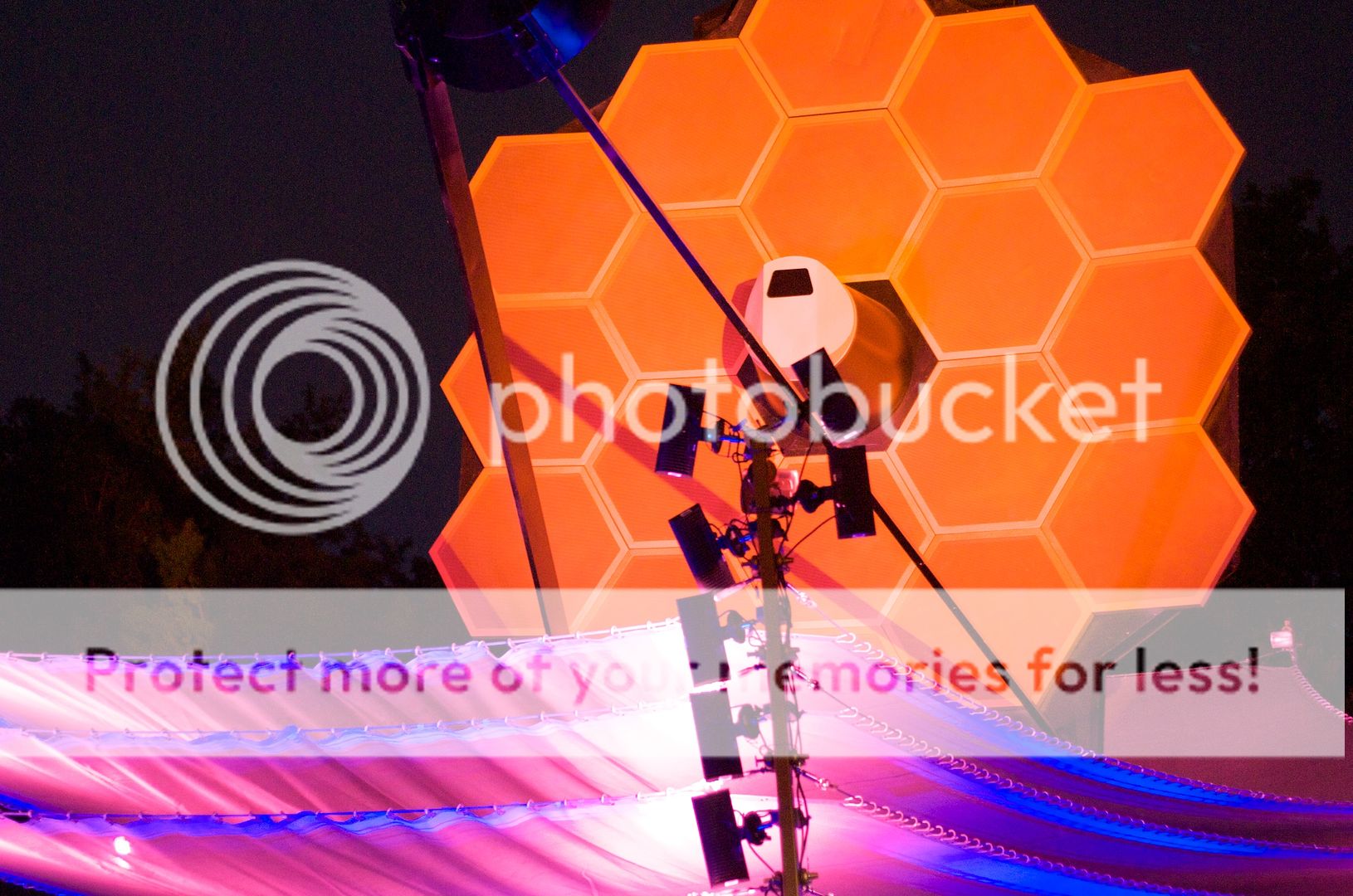
The James Webb Space Telescope is on display through Sunday, June 6, at 6pm, at Battery Park. Admission is free.
Jessica Stuart is a writer, photographer and videographer living in New York City. Find her on her personal blog, and Twitter.
ASTRONOMY’S NEW MESSENGERS — June 4, 2010
Marcia Bartusiak, the moderator at Friday night’s World Science Festival event Einstein’s New Messengers, walked on stage to a peculiar soundtrack. It wasn’t music at all, but a sharp thumping sound that started out in slow beats and, over the course of several seconds, progressed to a high-pitch whir like a baseball card in the spokes of bicycle wheel, before going out in an undignified “POP.”
It may not be beautiful, but it’s a sound physicists at the Laser Interferometer Gravitational-Wave Observatory (LIGO) are dying to hear—gravitational waves, emanating from colliding, super-massive black holes like ripples spreading out through a pond. “In a way, our universe has been like a silent movie,” said Bartusiak. “Gravitational waves are going to turn us into talkies.”
Gravitational waves aren’t actually sound waves—they are ripples in space-time, oscillations in the very fabric of the cosmos, caused by the movements of massive objects. The waves were predicted by Einstein’s general theory of relativity, but they have never been directly detected. That is, until…
Until soon, physicists hope. Among the most hopeful, to be sure, is Rainer Weiss, a member of Friday’s panel and the inventor of the massive experiment designed to detect them. The experiment, currently operating at five locations on earth, involves splitting a beam of light through the L-shaped, four-kilometer-long arms of an interferometer. If a gravitational wave passes through, one of the beams of light will be stretched while the other is squeezed, resulting in a tiny, eentsy, weensty difference in the amount of time it takes the light to bounce back to the middle.

Why are eight kilometers of laser necessary to detect a wiggle the size of the nucleus of a hydrogen atom? “The smaller the thing we’re trying to detect, the bigger the experiment we need to do it,” joked Kip Thorne, a theoretical physicist on the panel (and one of the world’s best experts on gravity).
On stage, Thorne and Weiss kept up a lively, good-natured banter over the merits of theory versus experimentation, while Andrea Lommen, an observational astronomer, talked about her preferred method of seeking out gravitational waves—by looking for small fluctuations in the energy emitted from pulsars. “Pulsars are my detectors,” she said. “I already have this galactic-scale detector that’s been given to me by the universe.”

Whatever their method, the three scientists are all hoping that the information riding in those elusive waves will allow them to gain insight into the remotest, strangest parts of the universe—from the formation of galaxies to time-creeping depths of black holes.
THE LIMITS OF UNDERSTANDING — June 4, 2010
One of the greatest public misconceptions about science, reinforced by our years of schooling and fat, glossy textbooks full of facts, is that it deals with stuff we already know about our world, when in fact all of science takes place at the boundary between what we know and what we don’t. And no one seems more aware of this than the panelists at Friday’s event The Limits of Our Understanding, at the World Science Festival.

The basis of the panel discussion was the idea of mathematical uncertainty or, more precisely, Godel’s incompleteness theorem, proposed in 1931, which says that it’s impossible to prove or disprove all of the parts of any formal system. “Eighty years later, we still don’t understand what Godel proved,” joked Gregory Chaitin, a mathematician and computer scientist. Then he added, more seriously, “the fallout hasn’t stopped.”
Perhaps, “the fallout” from Godel’s incompleteness theorem isn’t a semi-new phenomenon, but a problem that humans have been grappling with since the beginning of human thought. Mario Livio, an astrophysicist, compared it to Plato’s cave allegory, where the workings of the universe are played out by a fire in a cave, but we can only see the shadows cast on the wall. Are we describing the world as it really is, or only as we perceive it to be, with the fierce limitations of our senses?
And if we had other senses, Livio asked, and a different experience of the world—if, for example, we were jellyfishes living at the bottom of the Pacific Ocean, would we have invented arithmetic and geometry? Or what if our senses were simply altered? “If we saw in infrared, we might not have shapes,” he suggested. “It’s an artifact of our sense perceptions.”
“This is where absolute truth is gone!” cried Chaitin. “It’s gone nowadays—it’s out of fashion. But it’s still important to think about, because it might come back!”
Along with the argument about absolute and relative truth, the panel discussion ranged somewhat freely between each of the panelist’s subjects of interest—Rebecca Goldstein, a philosopher and novelist, brought up the question of consciousness, and suggested that the body of facts relating each of us to the natural world does not, in sum, add up to a complete description of the human experience.
Marvin Minksy, a cognitive scientists, disagreed. “Consciousness is just a bunch of different problems dumped into the same trash basket,” he contended. He pointed out that Galileo used the same word for velocity and momentum in his math, and the problem seemed like a very complicated one until someone came along and separated them into two different variables.
But along with this ardently demystifying view of human experience, and the somewhat depressing notion that the universe as we understand it is a mere matter of the tuning of our senses, Minsky gave us all a pretty good argument for showing up. “A molecule of DNA is stable room temperature for one billion years,” he said, but evolution itself is a random thing.
“Evolution remembers what works, but it doesn’t remember the ones that died.” It’s important for us to keep this in mind, he said, because it’s up to us to remember what works and what doesn’t—it’s up to us to transmit knowledge through time.
“Without culture,” Minsky said, “we don’t survive.”
Emily Elert is a freelance science writer living in New York City. Follow her on Twitter.
Follow the World Science Festival on Facebook and Twitter. All photography ©ScriptPhD.com. Please do not use without permission.
*****************
ScriptPhD.com covers science and technology in entertainment, media and advertising. Hire our consulting company for creative content development.
Subscribe to free email notifications of new posts on our home page.
]]>
The Hubble Space Telescope is the world’s first observatory that actually orbits—you guessed it—through outer space. Over the last decade, Hubble has captured some of the deepest and most detailed images of our universe. All those recent headlines about exoplanets: those discoveries come from Hubble. Scientists viewing pictures of light projected from stars over 13 billion years ago (almost at the origin of the universe): that’s Hubble, too. Hubble 3D documents the 2009 mission by the crew of the Shuttle Atlantis to make vital repairs to one of mankind’s most expensive, and significant, science projects. There would be no second chances. If the mission had failed, Hubble would be just another piece of junk orbiting above the earth, like my Direct TV satellite and Elvis’s body. The tension is real, the suspense extraordinary, and the imagery? Out of this world. And fortunately for terrestrial audiences, the entire mission was captured by the crew and director Toni Myers on some of the most breathtaking, brave film ever recorded. We are proud to make Hubble 3D an official ScriptPhD.com Editor’s Selection.
REVIEW: Hubble 3D
ScriptPhD Grade: A+ (Editor’s Selection)
How’s this for high stakes movie drama: NASA Mission specialist Mike Massimino, who was involved in the two previous missions making repairs and upgrades to the Hubble, a six foot three comedian who somehow conned NASA into putting him into orbit multiple times, squeezes inside the confined space of a delicate and incredibly expensive apparatus that was never intended to be modified once put into orbit. He has to access a circuit board behind 173 screws, which he must attempt to delicately handle in a space suit. If he bumps into something or a screw floats free it will put the whole telescope out of commission. To add extra danger to the mission, he’s handling sharp electronics which could tear his gloves, exposing him to extreme outer space conditions, and kill him.
The astronauts are the highlight of the film, as they provide a human element to this story in the stars. One thing Hubble 3D does very well is give the audience as close to an authentic experience as possible of space travel, which includes watching the astronauts make burritos in zero gravity, or hearing them talk about scratching your face before you put your helmet on because you won’t be able to touch it once you’ve suited up. But where the film really shines is through its spectacular 3D flythroughs of the births and deaths of stars, the super massive black hole at the heart of the Virgo cluster, and a cloud of newly forming galaxies. Take a look at some of the breathtaking cosmos imagery bestowed to scientists by the Hubble telescope:

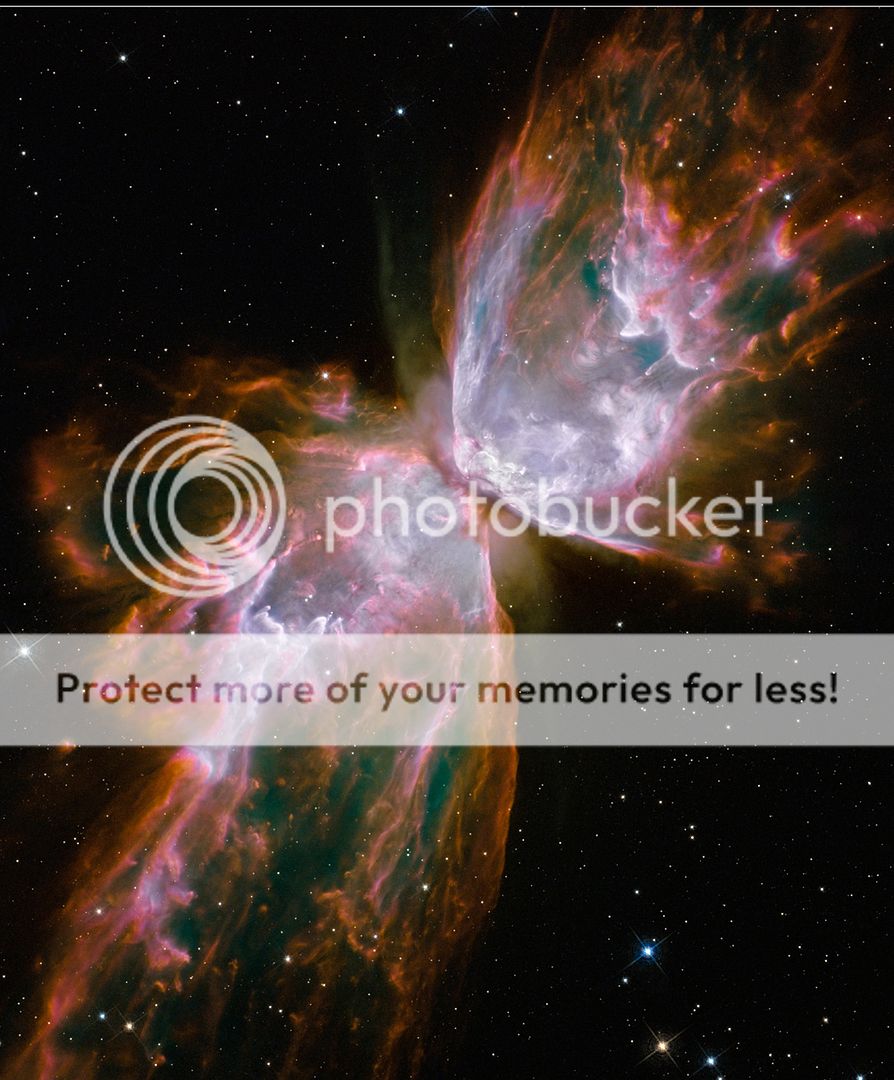
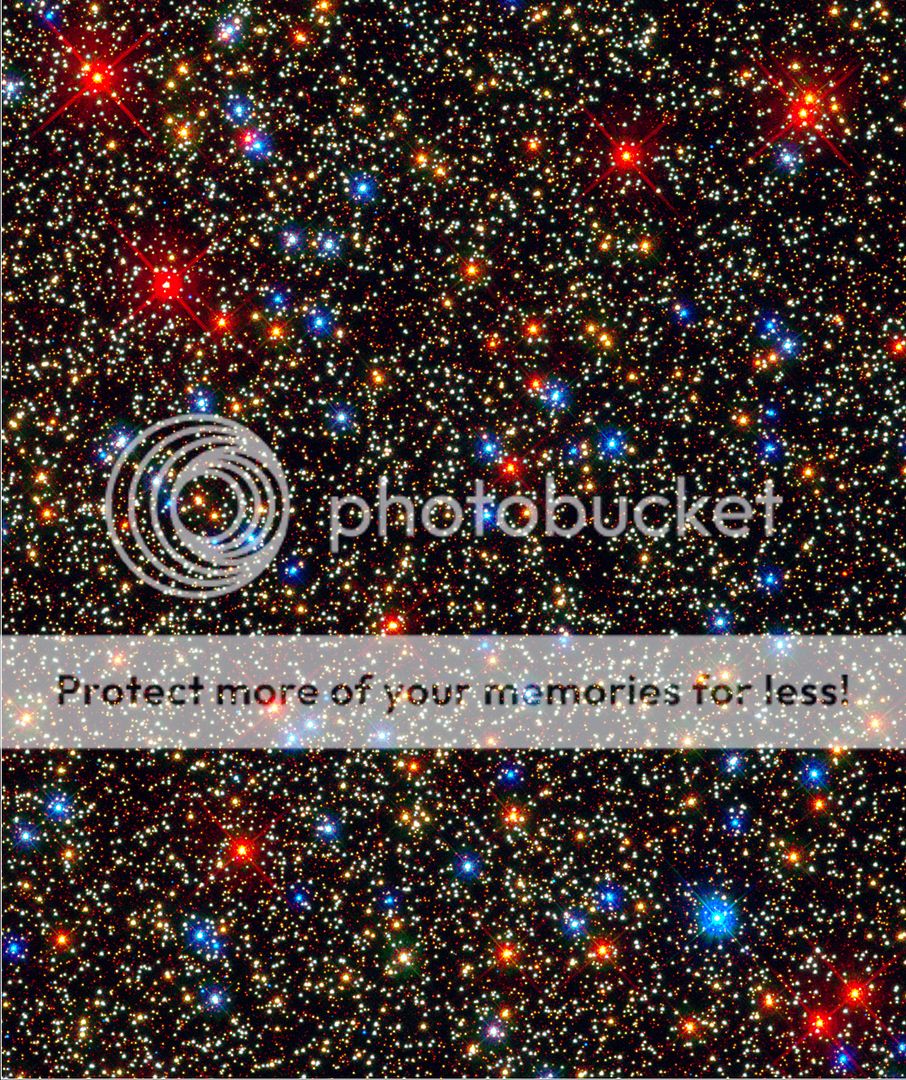
Director Toni Myers is a titan in the IMAX world. She’s worked in the format since its invention in the 1960s, and if you’ve ever seen an IMAX title having anything to do with nature or science, chances are she directed it. For the incredible flythrough sequences, she worked in collaboration with the Space Telescope Science Institute in Baltimore to produce the footage, then compiled them into a narrative with the supercomputer at the Advanced Visualization Laboratory at the University of Illinois at Urbana-Champagne. But let’s be crystal clear: none of the cosmos imagery is second-rate computer simulation; it’s all compiled from real data taken by the Hubble telescope.
There were other unique challenges in the making of this film. Myers couldn’t exactly send Director of Photography James Neihouse into space on the Atlantis, so they had to train the astronauts in the IMAX camera’s use. The Atlantis only had room for eight minutes of film capture, so they couldn’t afford to waste a single shot with bad focus or poor lighting conditions. If you’ve never witnessed a shuttle launch in person, Hubble 3D offers the next best thing with some truly visceral footage. Myers and Niehouse buried their 2 million dollar camera in a bunker of sand bags only 57 meters away from the launch site. The results are, as Massimino puts it, the closest most of us will get (and probably would ever want to get) to the actual feeling of a launch.
Leonardo Dicaprio’s narration is breathy and at times a bit hammy, but it’s hard to imagine a narrator who could do justice to the unbelievable scale of these images. Seeing the stars like this is a sublimely humbling experience. When the final images of the universe faded and the lights came up, many people around me (including ScriptPhD Editor Jovana Grbi?) were crying. If it sounds like I’m describing this movie as some sort of religious experience, well, you should just go see it for yourselves. Hubble 3D provides a captivating look at the fruits of one of mankind’s greatest scientific achievements.
Exclusive ScriptPhD.com Q&A with NASA’s Mike Massimino and Director Toni Myers
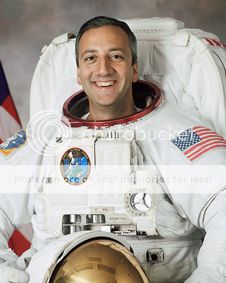
Mike Massimino is big for an astronaut, an attribute that made me nervous watching him crawl into the world’s most expensive telescope. But he’s also quite funny. Someone asked if he had any concerns about the film and he quipped: “Having to see my nose in 3-D.” He was also ecstatic about the film’s release because it was a rare opportunity to get his teenage daughters excited about something, not that their dad was an important astronaut on an important mission, or even that he’s in a movie, but that his name would be narrated by Leonardo DiCaprio.
Toni Myers has trained over 120 astronauts and cosmonauts in the art of IMAX photography. She directed the award-winning Space Station 3D along with many other space and nature-related IMAX pictures. After sending one of the most expensive cameras ever made into space, she had to wait an ulcer-inducing four weeks before the footage was rendered to see what the astronauts had actually filmed.
ScriptPhD.com joined a roundtable discussion with this pair to talk about the making of the film, the challenges of shooting in space, and the future of the American manned spaceflight program.
You were talking about how the night cycle offers this incredible view of the stars, and I wondered why we didn’t see more of that footage during the film?
Toni Myers: I can answer that- it has to do with shooting in IMAX–
Mike Massimino: You’d better. I just set the thing on auto and pressed the red button.
TM: -IMAX film is a 65 mm negative, so it just can’t capture stars during the night. If one of your prime shots happens during the dark you really can’t see it in IMAX. It’s
the equivalent of ASA 250 depending on how you rate it, it just won’t capture those wonderful images crews always talk about like lightning storms or aurorae.
Mike, how would you describe seeing the stars during a night pass?
MM: You know, when you first get to space you immediately run to the window and see that view during the day, and I remember my first flight I’d always be at the window during the day cycle and go ‘Ah, it’s dark, I’m gonna go downstairs’ until I decided to hang out at the window for a night pass, and I actually enjoyed the night passes as much or more as the day passes.
During the day it’s bright out, you can see the oceans and the clouds very clearly, when you go at night all of a sudden it’s like this magical time. You can see the line [of the approaching day pass]. And the stars, they don’t twinkle because they’re not coming through the atmosphere. They’re just these perfect points of light. You can see the gas from the milky way, you can see the Magellenic clouds, and all of the constellations like you’ve never seen before. It’s the greatest planetarium in the world. And you can also still make out the earth, sort of. Where the sky meets the earth there’s like this greenish bluish color where the sky meets the earth. And when you come over a city you can see the lights, kind of like when you’re on a plane, you see these clumps of light around cities. There was a lot of storm activity when we were flying over Australia at night time and you could see those thunderstorms light up the clouds from above. And you’re above it, you don’t see anything else, just the gases coming up from the clouds, it’s almost like it’s communicating-
TM: -It’s propagating.
MM: It’s almost like you’re spying on people. You’re flying over Europe or something, and you can see where people are living. You can see their light. You go over Africa and it’s pretty dark, maybe a few places with light. Japan is really cool because it’s all lit up and then you get those rings of light all around it, which I think are the fishing boats offshore. Then you come over the United States and it’s like a Christmas tree. The west coast is really lit up, you’ve got a lot of action up in the Chicago area, and up in the Eastern seaboard, man it’s just unbelievable. The signs of civilization over the US compared to the rest of the world are just incredible. You look down at Miami, and then there’s like a black-out in Cuba. They didn’t pay their electricity bill or something.
I had a question about the take-off. I was blown away, literally. How close are the cameras for that and are they destroyed?
TM: They are not sacrificial cameras, I wouldn’t have a job if I was destroying a couple million dollar cameras. They’re both in blast boxes, which are very protected and the one was actually on the pad looking up, 57 meters from the base of the shuttle. The box is literally drilled into the pad. It’s a hardwire start that NASA activates, and you have to time it before the launch so you have a handle on the shot before you get a bunch of dust in your face. And there are ¾ in. ports that the lenses look through, and we covered the whole thing in sand bags the day before so it looks like some kind of creature there. And we had a second one on top of the rotating structure above the shuttle. We had not actually done that position before and we knew there was gonna be significant motion in waves around it, but both came out really well.
MM: I was watching the movie for the first time with my wife in Washington, and I first thought my wife’s seat was shaking because of the sound from the movie during the launch, and then we realized it was me that was shaking. It really allowed me to relive this whole experience and allows me to share this experience with other people who weren’t there.
TM: I was shooting Space Station 3D and a rock went right through the ¾ in. glass on one of my cameras, and I thought, well, I’m spending the rest of my life in Kazakhstan, I can’t go home. But James [Niehaus] fortunately had put a neutral density filter in front of the lens in the camera and the rock hit the filter and just dropped, didn’t damage the camera, and as a result we had this 3D shot of debris coming towards the camera and shattering the glass, and when people watched that at the IMAX, many of them actually take their 3D glasses off and looked to see if they had shattered.
It’s not looking very good for our manned spaceflight program right now in this country, do you think people will look at this film and think maybe we’re making a mistake?
TM: I’d love to just say I think it’s a mistake and I certainly said so in this film. If we intend to go anywhere we need these skills, and at least a human and robotic partnership just like the space station. I think people need to understand that if you go back to the moon or especially if you go to Mars you’ve got to build some kind of infrastructure there and the things that crews have learned in the process of building a space station on orbit and how to live there on a permanent basis are everything you need for our future off the planet. I think we’ll look back and see this as just a minor little blip, if it is a blip. The Chinese will say they’re going to the moon tomorrow and everything will speed up.
MM: I think the movie does show people what we’ve been able to do with the shuttle here, and Toni mentioned the space station which was built by shuttle crews. I’m optimistic, I don’t think you’re gonna be able to kill the space program. Certainly throughout the world, we have a lot of partnerships with other countries , for example the Russians, who are our partners– we’re going to be using their space ships.
The shuttle program is ending, by the end of the year most likely we’ll be done, so you have to have something else. Going around the country with the support that we have from all the taxpayers who are paying for this thing and from politicians on both sides of the aisle, and from the president as well, I do not think that we’re going to accept not being a part of the international space community, and I mean sending people, not just the probes.
I think in America we see ourselves as explorers and enjoy being right in the heat of it. We’re not going to let other countries beat us, so I think we’re going to continue to send people into space and I think we’re going to want to have our own spaceships here to do that as a back up to the other countries. I think we’re going to have something, whether it’s going to be commercially developed, some kind of joint venture with NASA, will it take astronauts plus tourists, I don’t know how all that’s gonna be worked out, but I am convinced that we’re not gonna stop.
Why do you think it’s so important to send people into space?
MM: I need a job and I got these two kids going to college…No, in some ways it’s hard to justify, although Hubble 3D shows that we can do practical things, when Hubble breaks we can send people up there to fix it. When the bolt was stuck on the handle I was able to rip it off. We’re able to adapt and do things that you wouldn’t be able to do without a person on the spot. We’re all people here on this earth, we want to experience things first hand. Unfortunately not everybody can go there, but I think as a species we like to send at least some representatives out there to explore and see what’s going on so we can experience it as people. There’s no way that that argument can hold in any kind of budget discussion where it’s up against what the taxpayers can afford, but from just a human point of view I think that’s what’s going to keep us going in the end. We don’t want to just send a probe and take pictures, we want to have people see what it’s like to actually see a new world and describe what it’s like.
TM: To add one coda to that, I recently listened to former astronaut Mike Collins speak at the fortieth anniversary of the moon, which was a little more urgent, and what he said was that maybe we’re going to have to expand outward from this planet in the coming century because of a population explosion. There are very practical reasons. Think of how we look back at Galileo 500 years ago, I bet 500 years from now we will look back having established habitats elsewhere.
By the way, you can follow Mike Massimino on Twitter. He sent the historic first tweet from space during the Hubble repair mission.
Hubble IMAX 3D goes into limited IMAX release on March 19, 2010 and is in theaters nationwide in August.
View trailer:
Stephen Compson studied English and Physics at Pomona College. He writes fiction and screenplays and is currently working toward a Master of Fine Arts at UCLA’s School of Theater, Film & Television.
~*Stephen Compson*~
***********************
ScriptPhD.com covers science and technology in entertainment, media and advertising. Hire our consulting company for creative content development.
Follow us on Twitter and our Facebook fan page. Subscribe to free email notifications of new posts on our home page.
]]>It’s not often that world-renowned scientists crash in the heart of Hollywood to talk about Nobel Prize-winning physics research. But on a recent summer night, the ScriptPhD, along with a handful of lucky astronomy aficionados, was treated to a light show with a side of general relativity. At LA’s famed Laserium CyberTheatre, Yale physicist Charles Baltay, also known as the man responsible for Pluto’s demise, captivated a delighted audience with about 10 billion years of physics, starting from the Big Bang to Pluto’s demise. Continuing the physics theme was a visually stunning array of laser pyrotechnics set to the thematically appropriate tune of Pink Floyd’s “Dark Side of the Moon.” For Dr. Baltay’s lecture, entitled “Exploring the Dark Side of the Universe”, and the psychedelic imagery of the world’s most advanced laser light show, please “continue reading” under the jump.
Ivan Dryer, Pioneer of the Modern Laser Light Show

The evening’s festivities were graciously hosted and introduced by Ivan Dryer, founder of the Laserium and a Los Angeles legend in the world of entertainment technology. Mr. Dryer is generally considered to be the father of commercial laser light shows. Starting out as a filmmaker in the 1970s, Dryer transitioned movie lasers used primarily for film effects into a show at the Los Angeles Griffith Observatory under the name “Laserium”. Laserium shows went on to be played in 46 cities worldwide, and were viewed by over 20 million people, eventually gaining recognition as the longest running theatrical attraction in the history of Los Angeles. “I had no idea how popular this would be,” Dryer said. “It was supposed to be temporary and wound up as a career. As many as 20 million people have leaned back and watched the sky light up to music.” What made that experience so popular? Dryer thinks it’s something about the fundamental appeal of light: “The quality of that light triggers something in the brain, I think. It gets into the limbic system” — the central neurological structure where the passions reside — “and stirs things up. The light and the music trigger our deepest emotions.” The light and the music continue at the Laserium’s permanent new cybertheater in Hollywood. Anyone who goes from being an aspiring young astronomer to an aspiring young filmmaker gets the ScriptPhD.com seal of approval!

And speaking of astronomers, the audience was treated to a lecture by world-renowned cosmologist (and the man responsible for the astronomical demotion of Pluto), Dr. Charles Baltay. Dr. Baltay, a Higgins Professor of physics and astronomy at Yale University, was born in Hungary and raised in Bavaria shortly after World War II. After relocating to the States, Dr. Baltay received a physics PhD from Yale and taught at Columbia University. What follows is a rare lecture that makes esoteric physics and astronomy approachable and enjoyable to non-scientists and scientists alike, while deftly explaining the sophisticated cutting-edge frontier of the expanding cosmos.
Lecture: Exploring the Dark Side of the Universe with Dr. Charles Baltay
I’ll be talking about the dark side of the universe, but by this I don’t mean Washington politics or the CIA. I’ll be talking about something called cosmology.
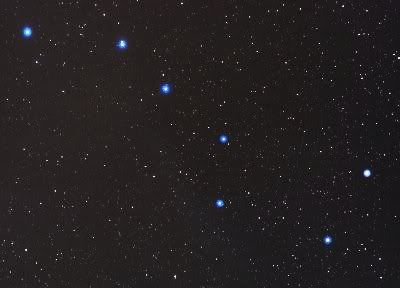
So this is our view of the large-scale structure and evolution of the universe. The first question is the structure. At small scales, the Earth is going around the Sun, the Moon around the Earth, there’s a lot of lumpiness, but when we look at the large scale, it’s very smooth and uniform. The next question is evolution—again, lots of irregular motion at small scales, and at the large scales, it’s pretty much the same as it’s been. Many of you might recognize this picture as The Big Dipper. It’s looked the same to the Greeks, to the Arabs, since recorded history, so our view was that the Universe was really not changing. It’s forever.
The questions we ask in cosmology are: is the Universe really static or is it evolving in some way? What is the age of the Universe? Is it infinite? Is there even a meaning to the age (if it’s forever then there’s no age)? What is the future development of the universe? What is the “stuff” that the Universe is made of?
Let me start by giving you the present view of the Universe. We believe that the Universe is not static but in a state of uniform expansion as an aftermath of the big explosion. This we call the Big Bang model.
We believe that we cannot see most of the “stuff” in the Universe. The picture above of the stars and galaxies is what we call “visible matter”. It turns out that visible matter comprises 1% of the stuff out there. Most of it is dark matter and dark energy, stuff we cannot see and that we don’t know very much about. And we believe that on the largest scales, the universe is very smooth and uniform. We believe that there is such a thing as an age, the time since the Big Bang. And we believe that to be 10-20 billion years. Some people say 13.2 billion [as in photo above], which may or may not be right, but that is a theory.
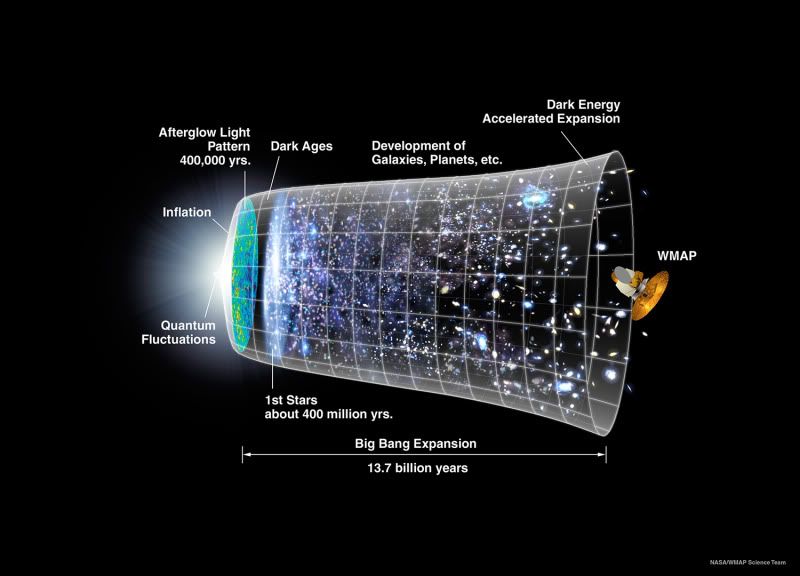
We don’t know the future of the Universe. It may keep expanding forever, like a big chill, or it may recollapse. Which will happen will depend on the amount and nature of this dark matter and dark energy. Right now we really cannot predict the future until we learn more about these properties. So this is a quick summary and you can now go to sleep for the rest of the lecture. [ScriptPhD note: we highly discourage this. It gets even better!]
To fill in a few details: how do we know all of this stuff? It doesn’t come from religious books, it’s not voodoo science. It started with a guy called Edwin Hubble who invented Hubble’s law. What he noticed is that distant stars and galaxies are moving away from us. The further something is, the faster it’s pushing away. That’s Hubble’s Law in a nutshell: the recession velocity is some constant times the distance. The point here is that the further away things are, the faster they’re rushing away from us.
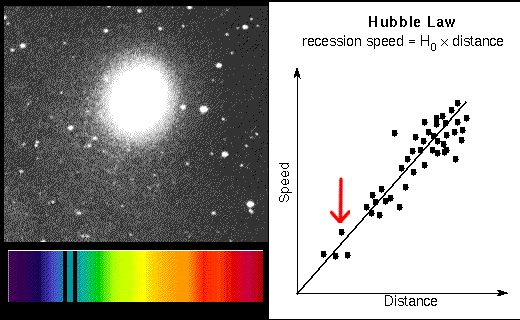
Now how does he know this? And the key idea here is something called the Doppler Effect. Light is a wave is a wavelength. And the wavelength determines the color. So blue is about 4,000 Angstroms, green is 5,000 and red is about 7,000 [see animated chart above.] The numbers here don’t matter. The longer the wavelengths look like red to your eye, the shorter wavelengths look bluish. We’ve all experienced the Doppler Effect. You’re on one of your beautiful freeways, if a car coming the other way blows their horn, you hear a high pitch and then as they pass it falls to a lower pitch, have you noticed this? [Note: to hear the Doppler Effect, click on the link below.]
The higher pitch is the shorter wavelength, then they pass you and they’re moving away from you, you get a lower pitch or a longer wavelength. So if the source is approaching the observer, you get shorter wavelengths, meaning towards the blue, so it’s called the Blue Shift. If something is moving away from you, then the pitch drops, you get longer wavelengths, which are redder, so it’s called the Red Shift. This is the whole clue to this [universe moving away faster] business. Measuring the red shift tells you the velocity that’s moving away from you. But how do you measure the red shift?
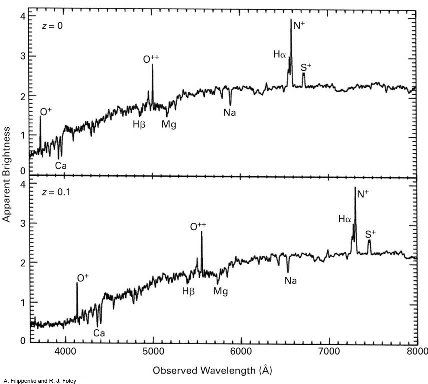
This picture is called a wavelength spectrum. This is a numerical representation of the wavelength of light coming from a distant star. And you notice certain items give you certain colors, like neon is a bluish color, and sodium lights a yellowish. Each of those colors show up as a line [represented by a specific wavelength]. It doesn’t take a rocket scientist to see that this top pattern is the same as that bottom pattern, but it’s displaced in wavelength [because it’s coming from a more distant star]. That’s how we measure the red shift. However much the wavelength is displaced, this tells you the red shift, which tells you the velocity. So what you do is look at a lot of distant stars in the galaxy, which is what Hubble did, measure their red shift from pictures like this, and figure out that the further away something is, the more rapidly it’s moving away.
Why does that mean an expanding universe? Suppose you go to a marathon in your city of choice and as usual you are late to things. So you arrive late and by the time you get there, you see that Sue the leader is 16 miles from the starting line. And she is running at 8 miles per hour. Joe is running at 4 miles per hour, so he only got 8 miles from the starting line. And some loser is only doing 2 miles per hour, so he only got 4 miles away. So if you all start at the same point, the faster you run, the further you get away. And that’s exactly Hubble’s Law [as relates to Universe expansion.] To put it another way: the further something is, the faster it’s running away from us. So that’s all there is to it. Very simple.
Suppose I come late to the marathon and I say to someone, “How long has this race been going on?” [the equivalent being, how old is the universe?] It doesn’t take an astronomer to say, 2 hours. If Sue is running at 8 miles per hour, she’s 16 miles from the beginning, the race has been going on 2 hours. So that’s the age of the Universe. All you have to do is measure how fast the galaxy is running away from us and how far the distance is, and you get the time. So the age of the Universe is the distance to some star divided by its velocity. But we make one big assumption here. That they’re running at a constant velocity. Suppose that Sue was really running faster, but is now getting tired.

So that brings up the next big question: is the expansion velocity of the Universe a constant or not? And you say that the answer is simple, because there is stuff in the Universe, like magnets, people, worms, stuff, gravity is attracted, so if the thing is expanding, gravitational attraction has slowed down the expansion. So we would expect the expansion of the Universe to slow down, to decelerate. And the rate of the deceleration tells you how much stuff there is. The more stuff, the more gravity, the more it slows down. But how do we measure these things? How can you measure what the velocity was in the past, say a billion years ago? If we are looking from Earth at a supernova (that’s an exploding star in the Universe), and let’s say that it was 1022 kilometers away. It takes light 3 billion years to get from the supernova to the Earth. So the light that we see today was really emitted 3 billion years ago. And the properties of that light tell us about the Universe as it was 3 billion years ago, and in particular, the red shift of that light tells you about the extension velocity of the light in the past. By looking at supernovas at different distances, you are indirectly measuring the expansion velocity of the Universe. Distance translates to time in the past, because light travels with finite velocity.
Scientists did this experiment and there was a huge surprise: the expansion velocity was smaller in the past and is bigger now. The Universe is accelerating! It has no business doing that. It cannot possibly do that [based on all the points discussed above]. All the laws of physics, and everything we know say that this cannot be. So this study came from guys at Harvard, so we didn’t believe them, but then people from Berkeley replicated the experiment and we now have to believe it. This is a strange state of affairs. All of the stuff in the Universe attracts gravity, and cannot cause it to accelerate. Scientists are not very smart and savvy, but we’re smart enough not to call the New York Times and say, “We just spent umpteen million dollars and we don’t know what the hell is going on.” So instead, we call the New York Times and say, “We discovered dark energy. What’s dark energy? We have no idea.” But dark energy is something that has to be pausing gravity. So we hypothesized dark energy is pushing the Universe apart and it’s qualitatively different from anything we think about, and it’s dark because we don’t see it. This is kind of where we are currently in this research field.
So we all recognize Albert Einstein, who came up with the Theory of General Relativity. And when you do the calculations and you put everything together, you come to this very startling conclusion: that the visible stuff in the Universe is 1%, and dark matter and dark energy are 99%. So all our physics books, the books in the Library of Congress are, but alas, 1% of the Universe. The rest [of the matter], we know almost nothing about. So the question is, how do we learn more about the age, the history and the future of the Universe? One thing we would like to do is look further back in cosmic time. The experiments we’ve done up until now have only gone back a short time, maybe 1 or 2 billion years. We would like to go back maybe 10 billion years to trace out this expansion velocity. Going back to our earlier example, I see Sue running the Boston Marathon, and I’d like to trace out her velocity from the beginning of the race. If I know that, I can reconstruct the exact age and predict the future. So going back further in time, long ago, means further away, because that is the direction the light is coming. Far away means these supernovas are very faint, so you have to go to space to look for them.
We have proposed a space mission [the SuperNova Acceleration Probe as part of the Joint Dark Energy Mission] to look for these supernovas to take us back further in time. On the other hand, you also need a sample of nearby supernovas to compare [them], and that we have to do from the ground, because they’re relatively bright since they’re close-by, but they are very rare. The ground experiments will give us the baseline supernovas and that is the Palomar Quest Survey which is underway at the Palomar Observatory not far from Los Angeles as a collaboration between our group at Yale and a group at the California Institute of Technology. The SNAP space mission [link above] is a proposal with about ten universities collaborating, and we’ll eventually have to launch one of these Delta-4 rockets in the future [view conceptualized animations of the project and space projections here].
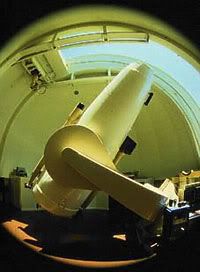

Here is a picture of the Schmidt Telescope that we are using at Palomar and a sample of some of the types of pictures that we are getting, such as the Andromeda Galaxy. But how do we find these supernova explosions? These are exploding stars, they take about two weeks to get to their peak brightness, and they take about six weeks to fade away. So we take one picture and compare it to a picture taken a month before, and then subtract the images to determine the supernova strength [see graphic in supernova picture above]. We have one big nuisance. And that is that in some of the images, you see an object moving over, and circling between the stars. That’s not a supernova explosion, it’s something that’s moving down the solar system. So within the background of the supernova search, are there other planets within our own solar system?

Back in the 1930’s, before computers, this guy named Dr. Clyde Tombaugh looked for 30 years by eye on photographs to find Pluto. And we’ve now started finding more planets, at least six to date, some that are bigger than Pluto:

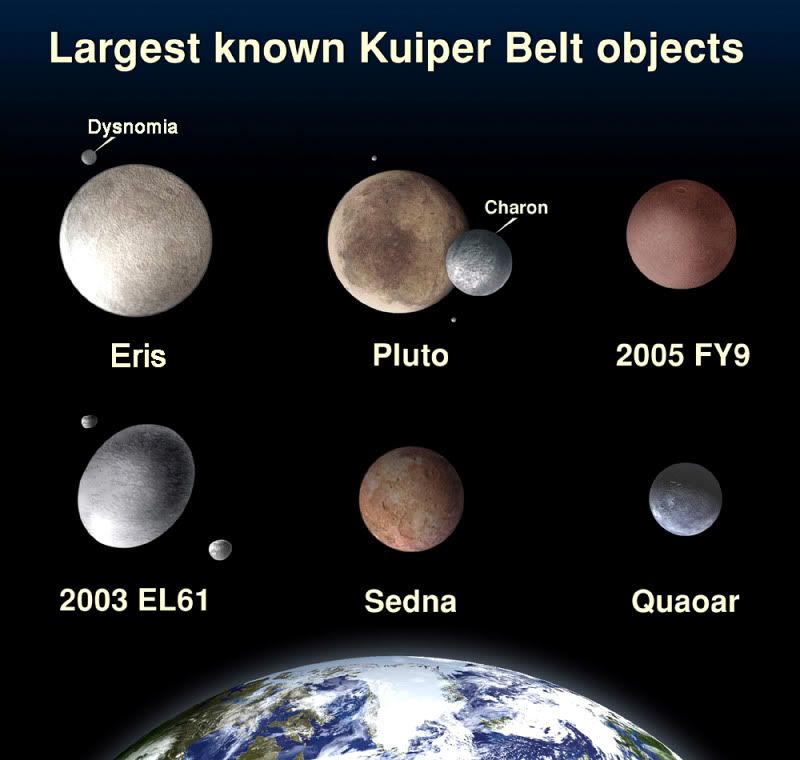
Because of these discoveries, we now believe that the solar system is probably twice as big as we used to think. So this upset people quite a lot and they said, “Either we call these guys planets, or we demote Pluto.” So that’s what happened. We have blood on our hands. Actually, what really happened is that everybody gets to be called a planet, with five inner planets, two giant planets, and four outer planets. And maybe we will find a few more [during the course of the Palomar survey]!
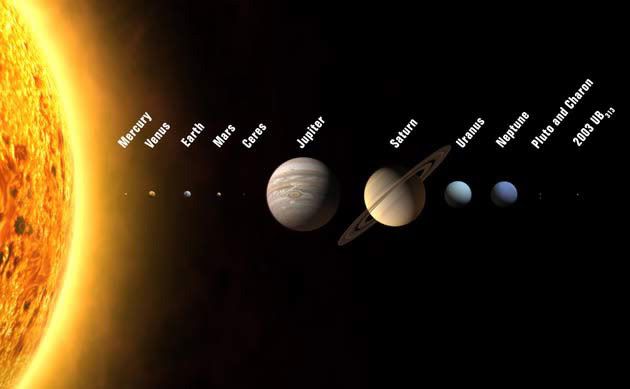
Question and Answer with Dr. Charles Baltay:
How often do you get lucky enough to witness a world-famous physicist answering questions and explaining high-order physics in every day layman’s terms? Not often. Following is the transcript of Dr. Baltay’s post-lecture question and answer session, during which his natural wit often shined through.
How is your work going to address dark energy and dark matter?
Charles Baltay: The approach we have now is to trace out the history of the expansion. And from that we can deduce how much dark energy there is. Of course, a more complete answer would be: take Einstein’s formulas of general relativity and… it gets complicated. But the basic idea is that the expansion history will tell you about the dark energy.
What got Pluto “declassified” when there are other planets that are much smaller?
CB: Well, declassified may not be the right word. It was reclassified as a minor planet, to make the distinction between the giant planets and the minor planets. So it’s an International Astronomical Union, and they spend their days arguing and this is what they came up with.
How do you determine the distance of the planets and supernovas you study?
CB: With great difficulty. Measuring distance is a big problem; that’s a hard thing to do. The reason I keep emphasizing supernovas—there are certain classes of supernovas that we know how bright they are intrinsically. So from the apparent brightness [of those standards] we can judge the brightness. It’s like a car headlight, if you knew how bright it was up close, then you see it from a distance, you could say the light passed off is 1/r2, from the intensity deduce the brightness [and ergo the distance]. And that’s why we pick out supernovas of all the possible things we could look at.
[ScriptPhD note: You must imagine the sassy molassy British girl asking this question—it’s so much more fun!] We know that there’s these lumps of rocks circling the sun. Why does it matter what we call them and is it really a good use of grown men’s time to argue about it?
CB: Well the International Astronomical Union has to have something to argue about. It’s a disappointing thing to argue about. You’re right—there are planets, there are asteroids, there are comets. So they are all things that go around the sun. So people like to classify. Biologists say that there are plants with three leaves on the end, versus five leaves on the end, and they give them names. So that’s what people do.
Sassy Molassy: It’s kind of an old-fashioned way to go about science, isn’t it?
CB: Well, yes. I don’t particularly find it exciting, but that’s my sole resistance to energy balance, whether we have 9 or 10 planets. Who cares?
Are you familiar with Stephen Hawking’s theory that there are singularities that are infinitely large and infinitely small? [Read about the Penrose-Hawking Singularity Theorems here.] And if so, do you believe that that might be an explanation for why there is spin and not just Big Bang thrust?
CB: Well, from what I understand about those theories, none of them encompass repulsive gravity. So dark energy is really different from anything that anyone’s talked about, in that it has repulsive gravity, and that’s what pushes the universe apart. So none of those weird things that people talk about—worm holes and singularities—none of those explain dark energy. We’re looking at something really quite new.
How does dark energy compare with the other forces, like gravity or electromagnetism?
CB: If I knew I’d publish immediately! We just don’t know.
Is there some correlation between the dark energy that you’re talking about and Einstein’s Cosmological Constant which predicts an expansion of the universe based on its properties of space?
CB: Yes. You’ve been reading books, obviously. OK, so let me mention a bit of history. Einstein wrote down his equation [E = mc2] in 1916, without a cosmological constant. He realized that that’s inconsistent with a static universe. In a sense, I can’t take this jacket hanging on this chair and leave it in the air. Gravity will make it fall down. So Einstein, revolutionary as his thinking was, firmly believed that the universe is static. This was before Hubble’s constant. So he said, “How can I fix up my equation?”, he put in this extra term, he called it his cosmological constant, which canceled out the gravitational attraction, and to him it was just an extra term. Then in 1930 Hubble said, “The universe is not static,” and Einstein said, “Oh, the cosmological constant is the biggest blunder of my career.” Now, I don’t know what he meant by that, because it couldn’t be one thing. Maybe what he meant was, “Had I stuck to my guns, and said the Universe cannot be static, I could have become famous!” [laughter] So from 1930 until just a few years ago, everyone used the cosmological constant. It was something that Einstein used to catch up his theory to be consistent with the semi-state universe. But we discovered that the universe is accelerating, maybe the cosmological constant is doing it. So that’s one candidate for dark energy.
Since waves tend to travel through mediums, is dark matter the medium by which light travels through?
CB: No. But how do I know that? I don’t think it is. We don’t know what dark matter and dark energy are. So it’s just the beginning of the story.
Are the experiments you talked about the only experiments happening on dark matter and dark energy?
CB: No. There are at least three or four more experiments being planned by various other techniques. It’s sort of a hot topic. It’s now the holy grail of cosmology. So a lot of people are doing it with different things. Of course we have the best design, but…
Can dark matter exist in a black hole, do you think?
CB: I don’t know. As I said, if I knew I’d publish.
Is there a number associated with Hubble’s Constant, just like pi?
CB: There is a number. It is hotly debated but the general values are described here. It’s not a number like pi, that’s a geometrical number. It’s a number that we have to measure.
What can your space telescope see that the Hubble cannot?
CB: The answer is the following. It’s called field of view. When you pick up a pair of binoculars, sometimes it has a very narrow field of view. And sometimes a big field of view. If you’re trying to find many, many supernovas, you want a wide field of view. The Hubble has a very narrow field of view. So we have to do something better than the Hubble. I’m being very modest today.
Now that we’ve discovered another [planet in the] Zodiac, how does that work with the horoscope? If you were a Leo, are you now a Virgo? [laughter]
CB: That’s beyond my pay scale.
Lights and Lasers and Pink Floyd, Oh My!
The highlight ending of this otherworldly evening was an hour-long bravura of luminescence to the soundtrack of “Dark Side of the Moon” by Pink Floyd. For those that have never experienced a show at this magnificent hidden Hollywood gem, it is, according to People Magazine, “the closest thing to tripping out in inner space.” Check out just a slice of the experience in pictures:







Our complete photographic collection from the show can be found as an extra feature on our Facebook fan page. Please credit all photography to ScriptPhD.com.
It would probably take extraordinary measures to travel far enough to see a distant supernova or nascent planetary body, but if you should find yourself in Los Angeles (or have been living here all your life) and want an exciting, explosive audiovisual scientific excursion, go to the Laserium’s permanent home in the heart of the Hollywood Walk of Fame. Great science amidst the global capital of entertainment… it doesn’t get better than that!
~*ScriptPhD*~
*****************
ScriptPhD.com covers science and technology in entertainment, media and advertising. Hire our consulting company for creative content development.
Subscribe to free email notifications of new posts on our home page.
]]>
